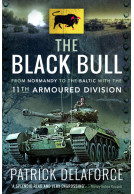Coastal Defences of the British Empire in the Revolutionary & Napoleonic Eras (Hardback)
Imprint: Pen & Sword Military
Pages: 240
Illustrations: 70 colour
ISBN: 9781526753458
Published: 26th April 2021
(click here for international delivery rates)
Order within the next 10 hours, 43 minutes to get your order processed the next working day!
Need a currency converter? Check XE.com for live rates
| Other formats available - Buy the Hardback and get the eBook for £1.99! | Price |
|---|---|
| Coastal Defences of the British… ePub (33.8 MB) Add to Basket | £6.99 |
Far more than an architecture book, Coastal Defences of the British Empire in the Revolutionary & Napoleonic Eras is a sweeping reinterpretation of the Martello towers, Grand Redoubts, Royal Military Canal and other new defence infrastructure.
Lavishly illustrated with period maps, views, portraits, cartoons and newly commissioned colour photographs, it includes not only these structures’ forerunners, and plans that were never executed, but also the grand strategy that informed them. At its best, this saw Britain’s position as a vast land battle, with the deadly threat of the French-held Antwerp navy yards on its own ‘left wing’, and Lisbon as the enemy’s ‘weak left’ to be ‘turned’.
The book also takes in the astonishingly inventive, bold and bloody small-boat wars that raged from the Baltic and Channel coast to Chesapeake Bay and Lake Ontario, and provides vivid pen-sketches of the now-obscure and sometimes deeply flawed strategic visionaries, engineers, inventors, and fighting men who held the line as – even after Trafalgar – the forces of an ever more powerful French empire circled like sharks.
Along the way, it traces a fundamental change in the nature of war and society: from a ponderous game of fortresses and colonies played by rulers, to murderous ‘foot by foot’ defence of the whole territory of the nation by ‘both sexes and every social type’.
The majority of the book offers a well-illustrated overview of the preparations made in the late eighteenth and early-nineteenth centuries against possible assaults along Britain’s coastlines and her scattered empire. Woven into this are more detailed descriptions of the forts and other defences erected during the period, and the weapons and tactics they were designed to resist. MacCannell is a fluent and capable writer who demonstrates throughout his book an ability to explain sometimes obscure information (such as the amount of powder required to propel shots of various sizes) in a way that makes it not just comprehensible, but interesting as well.
The Northern Mariner/Le marin du nord
Overall, Coastal Defences of the British Empire in the Revolutionary & Napoleonic Eras is a highly recommended read for anyone interested in military or architectural history, or the history of Britain and its empire during this period.
Medieval Sword School
Read the Full Review Here
Daniel MacCannell’s latest book explores the coastal defenses of Britain through a lens of military and architectural history. MacCannell’s work primarily covers the timespan between the 1770s and 1815, through the American Revolution, and Napoleon’s conquest of Europe. MacCannell pushes to enlighten his readers on the importance of coastal defenses when defending an island nation. The strategies used in traditional land-based warfare do not properly address the challenges of assaulting a landmass by the way of the sea. MacCannell’s writing guides the reader through the dangers which existed for seaside towns during this period, such as privateer raids, or enemy naval and amphibious infantry attacks. By providing this backdrop, the microhistorical views of particular forts, and defensive emplacements gain relevance for the overall narrative of the book. MacCannell’s choice placement of imagery continues to further the quality of the work by providing a visual stimulus for the reader.
Nautical Research Journal 67:3 (Autumn 2022).
MacCannell uses a series of full-color photographs, paintings, illustrations, and other visual aids to bring his architectural history to life for scholars. His use of photographs of the modern remains of Martello towers shown in contrast to historical paintings of events exemplifies the durability of these defensive emplacements. By showing the placement and usage of the towers which were destroyed, or demolished, the work helps to broaden the perspective for a historian researching the various forts and Martello towers.
MacCannell’s writing shows a passion for military history. The fifth chapter of this book, “Power and Shot,” is wonderfully written, giving elements of command decisions, mixed in with the industrial standardization of weaponry during the period covered by this book. MacCannell’s writing could take even a novice historian and walk them through the evolution of the weaponry of this period to a sense of firm understanding of the how and why for various rifles. Cannons and even rockets. The Martello tower history is the pride of this book. MacCannell gives a walkthrough of how and why these towers were built in Britain and the Canadian colonies, and how they were used to defend against and deter French ships. After explaining the nature of these towers, MacCannell writes of how the towers were used to prevent further incursion to British territories worldwide. In the final chapter of the book, “Endgame,” MacCannell reiterates that the coastal defenses of this period were a combination of multiple tactics which had been tested, proven, and then improved during the relatively short window of history covered by his well-designed book.
This book contains a remarkable amount of information, and the author displays an impressive grasp of British military history. This book is highly recommended, with an additional advantage of 70 illustrations, almost all in color, which make a very interesting book even more interesting.
Bolling W. Smith, Coastal Defense Journal
Featured on the website of
Portsmouth Napoleonic Society
Overall, this is a very interesting book, and the author has conducted considerable research using both archival records and more modern material. This research is presented in an easy-to-read format, and it is very educational. The book will appeal to many tastes and the author’s work is to be recognised, commended and praised for his hard work over many hours at archival facilities.
Dr Stuart C Blank, Military Archive Research
"The book is well produced, and lavishly illustrated, with some of the illustrations not having been seen by readers before."
The Napoleon Series
Read the full review here
The book is well produced, and lavishly illustrated, with some of the illustrations not having been seen by readers before. This book should be part of every enthusiast’s library.
John Morewood, The Waterloo Association
This is a book that will appeal to both the layman and the academic. It is superbly written, and the quality of presentation is first class.
Phil Curme
Recommended.
Read the full review here
The book is well produced, and lavishly illustrated, some of the illustrations will not have been seen by readers before. This book should be part of every enthusiast’s library.
Dr John Morewood, Friends of the Waterloo Committee Ass
The physical structures for the defence of the coasts are occasionally touched upon but rarely dealt with in detail. That this book does just that makes it special. The text flows easily and covers the political background, the designs and discussions around them and goes on to the building, equipping and manning of the great variety of structures. In addition to the British Isle overseas territories are covered. There are lots of illustrations placed in their relevant locations throughout the book. Among the extensive end notes there are many references out to further reading.
Clash of Steel
This is both an informative and enjoyable read which we recommend to all readers.
Read the full review here
This book is a most enjoyable and interesting read for any one interested in the Revolutionary and Napoleonic War. A treasure trove of information on two sides of the same coin, costal defence and amphibious operations. The emphasis on the coastal defence side of the book is on the concept, development and operation of the Martello towers both in the United Kingdom and the British Empire. Everything which you could possibly want to know about Martello towers is covered in this book.
Amazon Customer, Mr George R I Clarke
On the amphibious operations side of the book where is a detailed analysis of the threat of invasion of the United Kingdom posed by Napoleon Bonaparte both before and after Trafalgar. I now have a real understanding of the threat of invasion posed by Napoleon and of the steps that were taken to counter that threat. I was surprised to find out how serious that threat was and the extensive steps taken by the British government to counter that threat. The amount of energy, resources and brainpower employed to counter the threat is fully explained. In addition, the various amphibious operations carried out by the British during the Naponic war are also covered. What also surprised me was the fact that the British government did in fact learn lessons from the American War of Independence which for once were put into effect immediately and not left not left to wait for another war to start. The book is excellently illustrated by colour photographs and drawings throughout. For those interested in this period do not waste any time and order this book ASAP.
Read the full review here
This is a very well researched book about a fascinating historical phenomena, how Britain defended its coastlines both at home and abroad during the Napoleonic era. If you ever wondered about the line of south coast Martello towers along the English south coast, then this is the book for you.
Dr Adrian Greaves, The Anglo-Zulu War Historical Society
It first takes the reader to look at the history of the towers, from considering the problems involving shore defences both at home and in the colonies, to the idea of the towers and through to their actual construction. The book also deals with the delicate state of peace in the colonies through to the urgent need for some form of their physical defence at a time when the Royal Navy was over stretched.
I found the explanation for the towers along the English South Coast to be the most interesting and this book answered many questions I had about the towers, answers which had previously eluded me.
A well written and most interesting book.
A well constructed and serious work that is well supported by images. It brings together the context that determined the need to build and the enduring legacy of those structures.
Michael McCarthy
Michael McCarthy. Battlefield Guide
About Daniel MacCannell
Daniel MacCannell UE FRGS is an Aberdeen University-trained historian and Army Cadet Force instructor at HMS Flying Fox in Bristol. He has written extensively about the histories of smuggling, cartography, news, royalism, and architecture, and in a former life was hired to pen a series of Pink Panther cartoons for Metro-Goldwyn-Mayer. He is also a leading editor of advanced academic work written in English by speakers of Taiwan Mandarin. This is his ninth nonfiction book.














